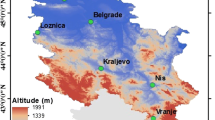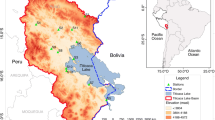Abstract
Medium range daily reference evapotranspiration (ETo) forecasts are very helpful for farmers or irrigation system operators for improving their irrigation scheduling. We tested four artificial neural networks (ANNs) for ETo forecasting using forecasted temperatures data retrieved from public weather forecasts. Daily meteorological data were collected to train and validate the ANNs against the Penman–Monteith (PM) model. And then, the temperature forecasts for 7-day ahead were entered into the validated ANNs to produce ETo forecast outputs. The forecasting performances of models were evaluated through comparisons between the ETo forecasted by ANNs and ETo calculated by PM from the observed meteorological data. The correlation coefficients between observed and forecasted temperatures for all stations were all greater than 0.91, and the accuracy of the minimum temperature forecast (error within ± 2 °C) ranged from 68.34 to 91.61 %, whereas for the maximum temperature it ranged from 51.78 to 57.44 %. The accuracy of the ETo forecast (error within ± 1.5 mm day−1) ranged from 75.53 to 78.14 %, the average values of the mean absolute error ranged from 0.99 to 1.09 mm day−1, the average values of the root mean square error ranged from 0.87 to 1.36 mm day−1, and the average values of the correlation coefficient ranged from 0.70 to 0.75. The results suggested that ANNs can be considered as a promising ETo forecasting tool. The forecasting performance can be improved by promoting temperature forecast accuracy.






Similar content being viewed by others
References
Allen RG, Pereira LS, Raes D, Smith M (1998) Crop evapotranspiration: guidelines for computing crop requirements. FAO Irrigation and Drainage Paper No. 56. FAO, Rome, Italy. http://www.fao.org/docrep/x0490e/x0490e00.htm. Accessed 9 March 2014
Amarasinghe U, Smakhtin V (2014) Global water demand projections: past, present and future. Colombo, Sri Lanka: International Water Management Institute (IWMI). 32p. (IWMI Research Report 156). http://www.iwmi.cgiar.org/Publications/IWMI_Research_Reports/PDF/pub156/rr156.pdf. Accessed 9 March 2014
Bakhtiari B, Ghahreman N, Liaghat AM, Hoogenboom G (2011) Evaluation of reference evapotranspiration models for semiarid environment using lysimeter measurements. J Agri Sci Technol 13:223–237
Ballesteros R, Ortega JF, Moreno MA (2012) FORETo: new software for reference evapotranspiration forecasting. Internation Conference of Agriculture Engineering CIGR-AgEng 2012, July 8–12, 2012, Valencia Spain
Barker R, Dawe D, Tuong TP, Bhuiyan SI, Guerrac LC (2000) The outlook for water resources in the year 2020: challenges for research on water management in rice production. Proceedings of the Nineteenth session of the International Rice commission in September 7–9, 1998, Cairo, Egypt, pp 133–142
Bhartiya KM, Ghare AD (2014) Relative humidity based model for estimation of reference evapotranspiration for western plateau and hills region of India. Water Resour Manag 28(10):3355–3364
Bogawski P, Bednorz E (2014) Comparison and validation of selected evapotranspiration models for conditions in Poland (Central Europe). Water Resour Manag 28(14):5021–5038
Cai J, Liu Y, Lei T (2007) Estimating reference evapotranspiration with the FAO Penman–Monteith equation using daily weather forecast messages. Agric For Meteorol 145:22–35
CMA (2005) Quality inspection of medium-short-term weather forecast. China Meteorological Administration, Beijing (In Chinese)
Hutson SS, Barber NL, Kenny JF, Linsay KS, Lumia DS, Maupin MA (2004) Estimated use of water in the United States in 2000 Reston, VA, U.S. Geological Survey Circular 1268, 46 p
Kim S, Kim HS (2008) Neural networks and genetic algorithm approach for nonlinear evaporation and evapotranspiration modeling. J Hydrol 351:299–317
Kisi O, Cengiz TM (2013) Fuzzy genetic approach for estimating reference evapotranspiration of Turkey: Mediterranean region. Water Resour Manag 27(10):3541–3553
Kisi O, Zounemat-Kermani M (2014) Comparison of two different adaptive neuro-fuzzy inference systems in modelling daily reference evapotranspiration. Water Resour Manag 28(9):2655–2675
Li GC, Lian ZL, Zhao YC, Niu CY (2009) Temperature forecast verification and its controls in Shijiazhuang, Hebei province. J Meteorol Environ 25(1):15–18 (Chinese with English abstract)
Liang DR, Zhu M, Yao DQ (2008) Forecast analysis and evaluation of Beijing, Wuhan, Shiyan and weather online. Hubei Meteorology Association, Wuhan, pp 16–17 (Chinese with English abstract)
Luo Y, Chang X, Peng S, Khan S, Wang W, Zheng Q, Cai X (2014) Short-term forecasting of daily reference evapotranspiration using the Hargreaves–Samani model and temperature forecasts. Agric Water Manag 136:42–51
Majidi M, Alizadeh A, Vazifedoust M, Farid A, Ahmadi T (2015) Analysis of the effect of missing weather data on estimating daily reference evapotranspiration under different climatic conditions. Water Resour Manag 29(7):2107–2124
Mallikarjuna P, Jyothy SA, Murthy DS, Reddy KC (2014) Performance of recalibrated equations for the estimation of daily reference evapotranspiration. Water Resour Manag 28(13):4513–4535
Marino MA, Tracy JC, Taghavi SA (1993) Forecasting of reference crop evapotranspiration. Agric Water Manag 24:163–187
NeuroDimension, Inc. (2014) NeuroSolutions for Excel. 2014. Gainesville, FL, USA. http://www.neurosolutions.com/documentation/NeuroSolutionsforExcel.pdf, Accessed 16 April 2015
Palmer CK, Osborne HD (2013) National weather service forecast reference evapotranspiration and verification across the western US. The 93rd American Meteorological Society Annual Meeting, January 05–10, 2013, Austin, TX, USA. https://ams.confex.com/ams/92Annual/webprogram/Paper196119.html Accessed 12 March 2014
Palmer C, Osborne H, Davis PK, Melton F, Hobbins M (2012) National weather service forecast reference evapotranspiration across the western US. The 92nd American Meteorological Society Annual Meeting, January 22–26, 2012, New Orleans, LA, USA. https://ams.confex.com/ams/93Annual/webprogram/Handout/Paper223261/FRET_AMS2013.pdf. Accessed 12 March 2014
Perera KC, Western AW, Nawarathna B, George B (2014) Forecasting daily reference evapotranspiration for Australia using numerical weather prediction outputs. Agric For Meteorol 194:50–63
Perugu M, Singam AJ, Kamasani CSR (2013) Multiple linear correlation analysis of daily reference evapotranspiration. Water Resour Manag 27(5):1489–1500
Rahimikhoob A (2014) Comparison between M5 model tree and neural networks for estimating reference evapotranspiration in an arid environment. Water Resour Manag 28(3):657–669
Samani Z (2000) Estimating solar radiation and evapotranspiration using minimum climatological data. J Irrig Drain Eng 126(4):265–267
Snyder RL, Palmer C, Orang M, Anderson M (2009). National weather service reference evapotranspiration forecast. Topic: Crop water use. 4, 1–6. http://www.waterplan.water.ca.gov/docs/cwpu2009/0310final/v4c03a12_cwp2009.pdf. Accessed 12 March 2014
Thornes JE (1996) The quality and accuracy of a sample of public and commercial weather forecasts in the UK. Meteorol Appl 3(1):63–74
Traore S, Wang YM, Kerh T (2010) Artificial neural network for modeling reference evapotranspiration complex process in Sudano-Sahelian zone. Agric Water Manag 97(5):707–714
Wang YM, Traore S, Kerh T (2008) Neural network approach for estimating reference evapotranspiration from limited climatic data in Burkina Faso. WSEAS Trans Comput 6(7):704–713
Zhang CJ, Chen YY, Niu JJ, Wu JJ (2009) An amendment method and release platform of precision weather forecast for Guyuan, Ningxia. Ningxia Eng Technol 8(2):105–108 (In Chinese)
Acknowledgments
This work was financially supported by the National Natural Science Foundation of China (NSFC 51179048), the Ministry of Water Resource under the Public Welfare Scientific Research Project (201301014-02) and Advanced Science and Technology Innovation Team in Colleges and Universities in Jiangsu Province. The observed meteorological data obtained from the China Meteorological Data Sharing Service System (http://cdc.cma.gov.cn) and weather forecast data from Weather China (http://www.weather.com.cn) are gratefully acknowledged. The authors would like to thank the anonymous reviewers for their precious and insightful comments and suggestions that greatly improved the quality of this manuscript.
Author information
Authors and Affiliations
Corresponding author
Rights and permissions
About this article
Cite this article
Luo, Y., Traore, S., Lyu, X. et al. Medium Range Daily Reference Evapotranspiration Forecasting by Using ANN and Public Weather Forecasts. Water Resour Manage 29, 3863–3876 (2015). https://doi.org/10.1007/s11269-015-1033-8
Received:
Accepted:
Published:
Issue Date:
DOI: https://doi.org/10.1007/s11269-015-1033-8




